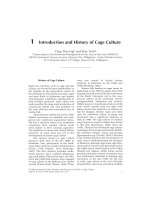INTRODUCTION AND OBJECTIVES
Bạn đang xem bản rút gọn của tài liệu. Xem và tải ngay bản đầy đủ của tài liệu tại đây (172.01 KB, 3 trang )
1 Introduction and Objectives
Polysaccharides are unique biopolymers with an enormous structural diversity.
Huge amounts of polysaccharides are formed biosynthetically by many organ-
isms including plants, animals, fungi, algae, and microorganisms as storage poly-
mers and structure forming macromolecules due to their extraordinary ability
for structure formation by supramolecular interactions of variable types. In addi-
tion, polysaccharides are increasingly recognised as key substances in biotransfor-
mation processes regarding, e.g., activity and selectivity. Although the naturally
occurring polysaccharides are already outstanding, chemical modification can
improve the given features and can even be used to tailor advanced materials.
Etherification and esterification of polysaccharides represent the most versatile
transformations as they provide easy access to a variety of bio-based materials with
valuable properties. In particular, state-of-the-art esterification can yield a broad
spectrumofpolysaccharidederivatives,asdiscussedintheframeofthisbookfrom
a practical point of view but are currently only used under lab-scale conditions.
In contrast, simple esterification of the most abundant polysaccharides cellulose
and starch are commercially accepted procedures. Nevertheless, it is the author’s
intention to review classical concepts of esterification, such as conversions of
cellulose to carboxylic acid esters of C
2
to C
4
acids including mixed derivatives of
phthalic acid and cellulose nitrate, which are produced in large quantities. These
commercial paths of polysaccharide esterification are carried out exclusively under
heterogeneous conditions, at least at the beginning of the conversion. The majority
of cellulose acetate (about 900 000 t per year) is based on a route that includes the
dissolution of the products formed [1–3].
Research and development offers new opportunities for the synthesis of
polysaccharide esters resulting from:
– New reagents (ring opening, transesterification), enzymatic acylation and
in situ activation of carboxylic acids
– Homogeneous reaction paths, i.e., starting with a dissolved polysaccharide and
new reaction media
– Regioselective esterification applying protecting-group techniques and pro-
tecting-group-free methods exploiting the superstructural features of the
polysaccharidesaswellasenzymaticallycatalysedprocedures
With regard to structure characterisation on the molecular level most important
are NMR spectroscopic techniques including specific sample preparation. Having
2 1 Introduction and Objectives
been extensively involved in polysaccharide research, we would like to stress that
a clear description of structure–property relationships is conveniently accessible
notonlyforthecommercialderivatives,butalsoforproductsofimprovedoreven
new features by this technique.
The combination of new esterification techniques, comprehensive structure
characterisation and detailed structure–property relationships is the key for
nanoscience and nanotechnology, smart and responsive materials with polysac-
charides and also opens new applications in the field of biosensors, selective
separation, bioengineering and pharmaceutics.
The objective of the book is not to supplement or replace any of the several
review articles and books in the field of polysaccharide chemistry and in particu-
1 Introduction and Objectives 3
lar esterification, but rather to describe the important features of typical synthetic
routes, efficient structure characterisation, and unconventional polysaccharide
esters including structure–property relationships. Additionally, comments about
selected new application areas are included. The methods of modification and
analysis described are mainly focused on glucans because they represent a large
part of naturally occurring polysaccharides. Moreover, glucans are structurally
most uniform. In contrast, polysaccharides consisting of various monosaccha-
rides and substructures, e.g., galactomannans, or algal polysaccharides exhibit
a broad diversity in properties caused by a large number of irreproducible factors.
Thus, the features of the algal polysaccharides vary extensively depending on the
seaweed species, the part of the plant the alginate was extracted from, and climatic
conditions at the time of growth [4]. Modification multiplies the structural and
property broadness, and is therefore of limited relevance for these polymers up
to now. Structure analysis is hardly achievable. Because most analytical strategies
and synthesis paths are adapted from the conversion of glucans, more complex
polymers will only be discussed if specific treatment is applied, e.g., esterification
of carboxylic acid moieties of alginates [5]. Among the broad variety of these
complex polysaccharides, the most important galactomannan guar gum, the algal
polysaccharide alginate, the aminoglucane chitin, the hemicellulose xylan, and the
fructan inulin are discussed to demonstrate the specifics of these polymers.
Although recently the chemical (ring opening polymerisation) and enzymatic
synthesis of polysaccharides and polysaccharide derivatives was experimentally
achieved (up to now rather low DP values of maximum 40 have been obtained) the
polymeranalogous modification of polysaccharides isolated from natural sources
is the most important route to new products today and will continue to be the most
important in the foreseeable future. Consequently, polymeranalogous reactions are
discussed exclusively. It should be pointed out that not necessarily a strictly poly-
meranalogous reaction (no change in DP) is required. On the contrary, a certain
degradation prior or during the reaction may be a desired goal.
We hopethis book fills a gap between various aspects ofpolysaccharide research
concerning biosynthesis and isolation, on one hand, and material science, on the
other hand. It is hoped that this book will be accepted by the scientific community as
a means to stimulate scientists fromdifferent fields to use the chemical modification
of polysaccharides as basis for innovative ideas and new experimental pathways.









